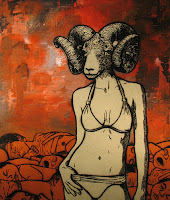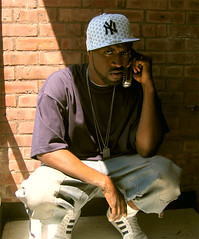The Black Ram: Barack Obama and the Othello Complex
Back to the image at hand.

In my last entry, I noted the ways in which this image works to secure and activate the sociopolitical capital afforded to nuclear family in presidential campaigns. Essentially, I thought it might be important to identify the ways in which the democratic candidate running a campaign based on “change” was actually endorses one of the most traditional, most problematic American values: the operation of patriarchy within the nuclear family.
What I want to suggest in this entry is that there’s more at stake in this emphatic focus on the family than merely helping the Obamas fit into the mold of what the picture-perfect first family should look like. There’s more to this than making Obama appear to be just like every other presidential candidate we’ve seen. This focus on the family also works to manage stereotypes about the threat that black men (and their sexual appetites) pose to American society.
I call this anxiety the Othello complex. If you’re not familiar, Othello was a Moorish army general in the service of the Duke of Venice. Though he boasts noble lineage and countless battlefield feats, neither accomplishment prepared Othello to navigate the social mores of Venetian society. So, when Othello falls in love with and secretly weds the Duke’s daughter Desdemona, it’s no surprise that Venice loses its mind.
If you’re not familiar, Othello was a Moorish army general in the service of the Duke of Venice. Though he boasts noble lineage and countless battlefield feats, neither accomplishment prepared Othello to navigate the social mores of Venetian society. So, when Othello falls in love with and secretly weds the Duke’s daughter Desdemona, it’s no surprise that Venice loses its mind.
The story ends in a murder/suicide, providing us with a cautionary tale about the dangers that arise when a religious and/or racial Other misjudges and transgresses the established social order. Of particular interest is the way in which Venice formulates/characterizes the particular threat that Othello poses to Venetian society. Iago yells “Even now, now, very now, an old black ram/Is tupping your white ewe”. Here, we see that in alerting Venice to the repercussions of the Other's intrusion/integration, Iago enlists the animalistic sexual metaphor of a black ram fucking a white sheep.
The white sheep is actually a metaphor for the virginal white maiden Desdemona, who herself symbolizes the vulnerability of Venice's geographic and conceptual borders. Allowing Othello to cross their national boundaries, Iago indicts, enabled him to penetrate her anatomical boundaries in turn. By wooing her into dishonoring her filial obligations and sullying her with his animalistic "tupping", Othello introduces a significant threat to Venice's nuclear family structure and the purity of  its bloodlines. In other words, the sexual prowess of the "black ram" carries with it the potential to destabilize entire social orders, particularly when a white maiden is the object of its desire.
its bloodlines. In other words, the sexual prowess of the "black ram" carries with it the potential to destabilize entire social orders, particularly when a white maiden is the object of its desire.
As such, I use the phrase the Othello complex to reference the fear of the empowered black male entering white society with a certain amount of celebrity and deploying that celebrity to trample upon its mores and pillage its women.
Enter Barack Obama.
If we consider the Othello story alongside the stereotypes of black men as well-endowed, hyper-sexual bucks with violent tempers and no capacity for reason, we can glimpse the caricature that the Obama camp must operate against. To establish Barack as a viable black male candidate, it was imperative that the Obama camp generate a public image of him that countered each of these stereotypes. And where better than the campaign website to take up the work of visualizing Barack as a respectable, smiley, family man capable of exhibiting the tenderness required to love his black wife and to raise two young daughters than his campaign website? This is the context in which I read the image in question. By flanking Barack with his wife and kids, this photograph domesticates Barack as to suspend our fears of the sexual threat he poses to our society. The image insists that there’s no easily-angered Moor here, folks. No belligerent battlefield buck to be found. What we have here is a man who shares one of our most important core values: patriarchy.
This is the context in which I read the image in question. By flanking Barack with his wife and kids, this photograph domesticates Barack as to suspend our fears of the sexual threat he poses to our society. The image insists that there’s no easily-angered Moor here, folks. No belligerent battlefield buck to be found. What we have here is a man who shares one of our most important core values: patriarchy.
This packaging of Barack provides us with many gifts… many assurances of the degree to which the threats he might posed have been neutralized, domesticated and made safe for America. Many of the elements that position him as non-threatening are foregrounded and heralded in the image:
1. He is happily married. So, (presuming no more oval office indiscretions) the precious national resource that is the purity of white femaleness is safe from his untamable libido.
2. He only has daughters. So, we can presume that he will produce no male heir to extend his legacy. (A very real fear given what we’ve endured at the hands of the Bush dynasty.)
3. The blackness of his wife and daughters mark the end of racial mixing within the Obama family. Whereas Obama’s Kenyan father and Kansan mother realized one of our worst fears when they transgressed national and racial boundaries, this image assures us that Barack will spare America a repeat of that disgrace.
So, yes. This image does a significant amount of work to address and minister to anxieties about preserving the purity of white bloodlines and the operation of white supremacy itself. To be sure, this anxiety has not been a nebulous theory circulating on the periphery on the campaign. No ma’am. In a true sign of the times, it came to a head in the form of a viral video. As if the latent, age-old stereotypes weren’t enough, Obama’s candidacy was publicly and irrevocably racialized and sexualized when the world watched a very sexy, very white woman confess her love for him.
The image responds to Obama girl’s now infamous videos:
"I Got a Crush...On Obama"
Wrought with sexual innuendoes (“I like it when you get hard…on Hillary in debates”), “I Got a Crush…On Obama” was an instant internet hit, garnering over one thousand views within the first five hours of its June 2007 posting. In it, the troupe of the white woman incited to sexual frenzy by the virile black buck is deployed ad nauseum. And although the clip invites us to read it as parody, the impact it had on the Obama campaign and the Obama family were no laughing matter for the presidential hopeful.
When asked about the video by the Des Moines Register on June 18, 2007, Obama said, "It's just one more example of the fertile imagination of the internet. More stuff like this will be popping up all the time”. All things considered, this was a pretty flippiant response to the wildly popular YouTube video. Two months later, however, Obama changed his tune and offered a response that would reveal just how significant an impact the lusts of scantily clad white girls can have on a presidential campaign.
On August 23, Obama told the Associated Press that the video had upset his daughters, lamenting that "You do wish people would think about what impact their actions have on kids and families." In the two months since the initial interview, it appears, the Obama camp re-framed/re-directed the candidate’s response from dismissing the hogwash that clutters the internet to heralding a platform of family values.

The latter response positions Obama not as a blameless victim of an internet prank, but as a protective father concerned about the degree to which his incorrigible daughters can believe in the strength of their nuclear family. Obama longs for the day when neither mainstream media nor the internet can stop little girls from believing that the only woman that loves daddy is mommy. And we, as a nation of failed monogamists and broken homes, presumably share in his longing.
 Of course, this strategy is a necessary and timely one for Barack Obama. As a black senator and presidential candidate, he operates in orbit with two very important icons in American political history. The first is Harold Ford Jr., whose 2006 senate run was marred by an ad wherein a blonde white woman recalls meeting Ford at a Playboy party. Speaking in a squeeky voice and suggestively asking Ford to call her, the white woman brought the Othello complex into full relief within the senate race.
Of course, this strategy is a necessary and timely one for Barack Obama. As a black senator and presidential candidate, he operates in orbit with two very important icons in American political history. The first is Harold Ford Jr., whose 2006 senate run was marred by an ad wherein a blonde white woman recalls meeting Ford at a Playboy party. Speaking in a squeeky voice and suggestively asking Ford to call her, the white woman brought the Othello complex into full relief within the senate race.The ad was denounced by many people, including former Republican Senator and Secretary of William Cohen, who called it “a very serious appeal to a racist sentiment.” Even Ford’s opponent Bob Corker asked the Republican leadership to pull the ad, which it refused to do. Corker subsequently pulled ahead in the polls and went on to defeat Ford in the November election by a narrow 3% margin.
The second figure with whom Obama must is former President Bill Clinton, the charming womanizer whose indiscretions and subsequent impeachment brought shame to our nation. Though white, the specter of Bill Clinton requires Obama to be even more emphatic in presenting himself as a stable family man, rather than reminding America’s of the libido that is the birthright of the young and charismatic. Afterall, if a white man can do what Bill did, imagine what havoc Barack’s black libido will wreak.
All that to say this:
In a time when Hillary Clinton is garnering support for her presidency based on her graceful endurance of one of America’s worst political scandals… A time when 38 year-old Harold Ford is poised to marry his 26 year-old white girlfriend (who is very much of the Obama Girl variety)… A black presidential candidate has to navigate the Othello complex as carefully as he can.
Having selected the image of his smiling, loving, middle-class family to open BarackObama.com, methinks the Obama camp is attempting to do just that. As such, it may be fruitful for us to be more attentive to the nuanced ways in which stereotypes based on race, gender, sexuality are intersecting in the 2008 presidential campaign to create vectors of privilege and penalty for the candidates..








